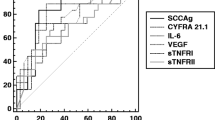Abstract
This study seeks to define the role of pre-treatment of evaluation of tumour growth fraction in cervical cancer and its relationship to the clinical course of the disease. In addition, it also seeks to explain whether cell kinetics and growth factor expression have an association with tumour response to radiotherapy and hence could be of value in the management of patients. All pre-treatment biopsies were analysed for the tumour-proliferative compartment by evaluation of Ki67 antigen expression and argyrophilic nucleolar organiser region (AgNOR) counts. Growth factor analysis was done by analysing for expression of epidermal growth factor (EGF), epidermal growth factor receptor (EGF-R) and transforming growth factors α and β (TGFα, TGFβ). A total of 152 patients were evaluated and a correlation obtained between pre-treatment status of the tumour-growth-fraction-associated markers and clinical outcome following radiotherapy. Such patients were either disease-free (group 1, n = 106) or with residual/recurrent disease (group 2, n = 46) at a 16-month follow-up. Pre-treatment analysis of AgNOR significantly correlated to disease status after treatment (r = −0.517, P = 0.0000). This may be due to an effect of cell proliferation. Lower AgNOR counts were significantly associated with recurrent/residual tumours, suggesting that increased proliferative activity may be a positive prognostic indicator. Similar results were also obtained for the other proliferation-associated marker Ki67 (r = −0.443, P = 0.0000). Expression of EGF and EGF-R also showed significant pre-treatment correlations with the final disease outcome (r = 0.248, P = 0.031 and r = 0.503, P = 0.0000 respectively). Both these markers were expressed more by patients belonging to group 2. The opposite was the case for TGFα, where patients belonging to group 1 showed higher values (r = 0.417, P = 0.0001). The other growth factor investigated, TGFβ, also showed a conspicuous differential expression in the two groups of patients (r = −0.604, P = 0.0000). Group 1 patients showed mostly mild to moderate expression while most group 2 patients were negative for the growth factor. It therefore appears that tumours with high AgNOR counts and Ki67 index, along with expression of the two types of transforming growth factor (α and β), responded better to radiotherapy.
Similar content being viewed by others
Author information
Authors and Affiliations
Additional information
Received: 9 February 1998 / Accepted: 14 April 1998
Rights and permissions
About this article
Cite this article
Radhakrishna Pillai, M., Jayaprakash, P. & Krishnan Nair, M. Tumour-proliferative fraction and growth factor expression as markers of tumour response to radiotherapy in cancer of the uterine cervix. J Cancer Res Clin Oncol 124, 456–461 (1998). https://doi.org/10.1007/s004320050199
Issue Date:
DOI: https://doi.org/10.1007/s004320050199




